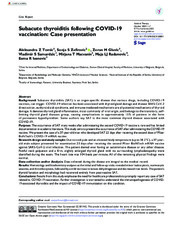Приказ основних података о документу
Subacute thyroiditis following COVID-19 vaccination: Case presentation
| dc.creator | Tomić, Aleksandra | |
| dc.creator | Zafirović, Sonja | |
| dc.creator | Gluvić, Zoran | |
| dc.creator | Samardžić, Vladimir | |
| dc.creator | Mačvanin, Mirjana | |
| dc.creator | Radunović, Maja | |
| dc.creator | Isenović, Esma R. | |
| dc.date.accessioned | 2023-11-06T09:45:49Z | |
| dc.date.available | 2023-11-06T09:45:49Z | |
| dc.date.issued | 2023 | |
| dc.identifier.issn | 1359-6535 | |
| dc.identifier.uri | https://vinar.vin.bg.ac.rs/handle/123456789/11875 | |
| dc.description.abstract | Background:Subacute thyroiditis (SAT) is an organ-specific disease that various drugs, including COVID-19vaccines, can trigger. COVID-19 infection has been associated with thyroid gland damage and disease SARS-CoV-2direct action, euthyroid sick syndrome, and immune-mediated mechanisms are all potential mechanisms of thyroiddamage. It denotes thyroid gland inflammation, most commonly of viral origin, and belongs to the transitory, self-limiting thyroid gland diseases group, causing complications in approximately 15% of patients in the formof permanent hypothyroidism. Some authors say SAT is the most common thyroid disease associated withCOVID-19.Purpose:The occurrence of SAT many weeks after administering the second COVID-19 vaccine is rare and has limiteddocumentation in academic literature. This study aims to present the occurrence of SAT after administering the COVID-19vaccine. We present the case of a 37-year-old man who developed SAT 23 days after receiving the second dose of PfizerBioNTech’s COVID-19 mRNA vaccine.Research design and study sample:Due to neck pain and an elevated body temperature (up to 38.2°C), a 37-year-old male subject presented for examination 23 days after receiving the second Pfizer BioNTech mRNA vaccineagainst SARS-CoV-2 viral infection. The patient deniedever having an autoimmune disease or any other disease.Painful neck palpation and afirm, slightly enlarged thyroid gland with no surrounding lymphadenopathy wereidentified during the exam. The heart rate was 104 beatsper minute. All of the remaining physicalfindings werenormal.Data collection and/or Analysis:Data collected during the disease are integral to the medical record.Results:Hematology and biochemistry analyses at the initial and follow-up visits revealed minor leukocytosis, normocyticanaemia, and thrombocytosis, followed by a mild increase in lactate dehydrogenase and decreased iron levels. The patient’sthyroid function and morphology had recovered entirely from post-vaccine SAT.Conclusions: Results from this study emphasise the need for healthcare professionals to promptly report any case of SATrelated to COVID-19 vaccination. Further investigation is warranted to understand the immunopathogenesis of COVID-19-associated thyroiditis and the impact of COVID-19 immunization on this condition. | en |
| dc.relation | info:eu-repo/grantAgreement/MESTD/inst-2020/200017/RS// | en |
| dc.rights | openAccess | |
| dc.rights.uri | https://creativecommons.org/licenses/by-nc/4.0/ | |
| dc.source | Antiviral Therapy | en |
| dc.subject | COVID-19 | en |
| dc.subject | Pfizer BioNTech vaccine | en |
| dc.subject | subacute thyroiditis | en |
| dc.title | Subacute thyroiditis following COVID-19 vaccination: Case presentation | en |
| dc.type | article | |
| dc.rights.license | BY-NC | |
| dc.citation.volume | 28 | |
| dc.citation.issue | 5 | |
| dc.identifier.doi | 10.1177/13596535231208831 | |
| dc.identifier.pmid | 37861754 | |
| dc.type.version | publishedVersion | |
| dc.identifier.scopus | 2-s2.0-85174962543 | |
| dc.identifier.fulltext | http://vinar.vin.bg.ac.rs/bitstream/id/32591/tomic-et-al-2023-subacute-thyroiditis-following-covid-19-vaccination-case-presentation.pdf |
Документи
Овај документ се појављује у следећим колекцијама
-
Radovi istraživača
Researchers' publications

